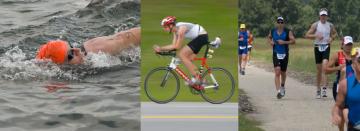Copyright © University of Cambridge. All rights reserved.
'Olympic Triathlon' printed from https://nrich.maths.org/
Show menu
Olympic Triathlon printable sheet - data
 In a triathlon, competitors take part in three disciplines: swimming, cycling and running.
In a triathlon, competitors take part in three disciplines: swimming, cycling and running.
The Olympic triathlon consists of a 1.5km swim, a 40km cycle, and a 10km run, completed in sequence. The first person to finish wins.
Do you think the triathlon will be won by someone who is very strong in one event and average in the other two, or someone who is strong in all three disciplines?
Take a look at this spreadsheet showing the results from the 2008 Beijing Olympics Men's Triathlon.
What do you notice?
You may find it helpful to sort the results in various ways, work out averages and measures of spread, or plot some graphs to test correlations between times for individual events and overall finishing positions.
Can you come up with any explanations for what you have noticed?
This spreadsheet contains results from male and female Olympic Triathlons since the introduction of the event in 2000.
Do the results from the other years mirror what you noticed about the 2008 Men's Triathlon?
Are your explanations for the 2008 results plausible for the results from other years too?
Are there any events with unexpected results, or outliers?
Send us anything interesting that you notice, together with graphs or statistics that highlight what you have noticed and your suggested explanations.
Triathlon swimming, and in particular cycling, is affected by a phenomenon called drafting. Click below to read more about drafting. Does it help to explain the spread of times in the different events?
In cycling, the majority of the work done at racing speeds will be to battle air resistance. This means that drafting has a large effect: a rider in a peloton (a large cluster of cyclists) can use over 30% less energy to move at the same speed as a cyclist riding alone. Drafting can be both co-operative and competitive: a small group of cyclists can work together to maintain a high speed in a paceline, rotating the lead position (who must work hardest) between them; alternatively, a lone rider can try to sit on the wheel of a competitor, allowing them to do the harder work and conserving energy for later. To try and get ahead of a peloton is called a break or a breakaway, and is difficult for the lone rider. This makes teamwork a very important part of cycling.
Drafting also has an effect on swimming, because the main work is done against the drag from the water. Because of the much lower speeds involved, the slipstream of each swimmer is more spread out. This means that to draft in swimming, one can be adjacent and slightly back from the swimmer in front, instead of directly behind as in cycling. In swimming events without lanes, such as the triathlon, competitors frequently form groups and lines just like pelotons and pacelines.
If you have access to YouTube, you can try to observe the effects of drafting in the following videos from the 2008 Beijing Olympics: Men's Triathlon and Women's Triathlon.